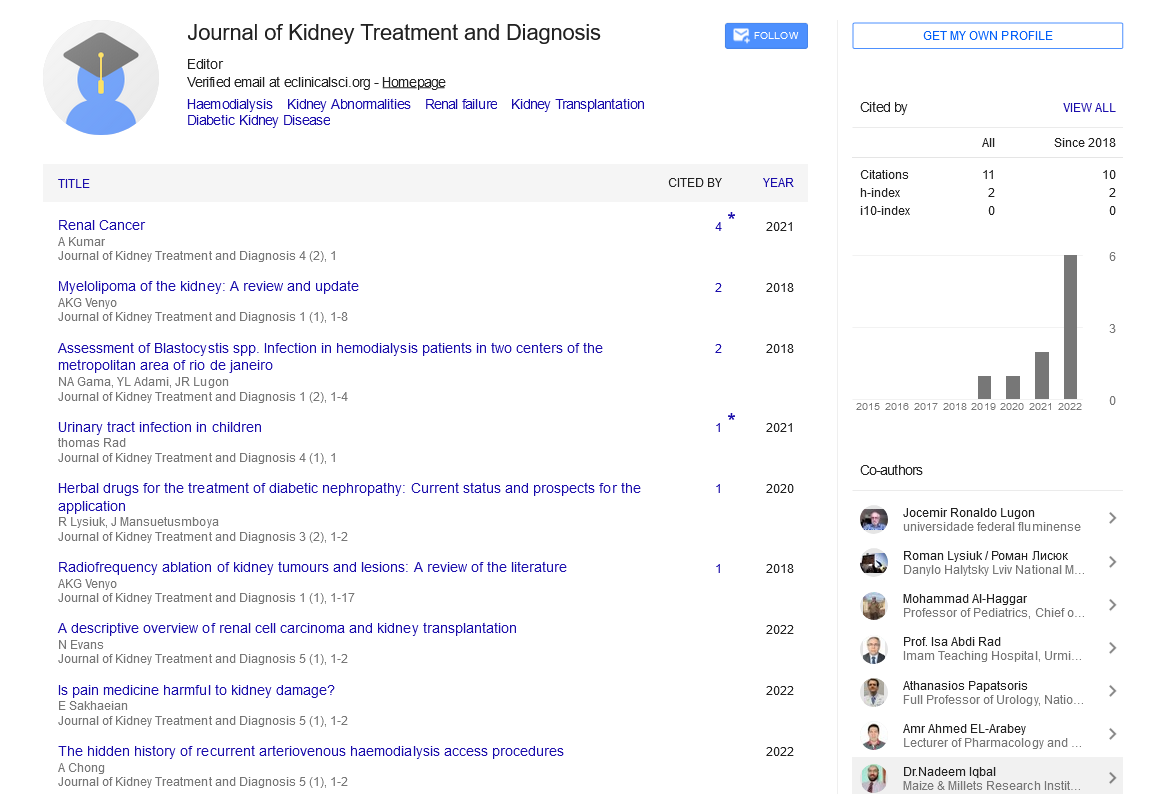Urinary tract infection in children
Received: 01-Jan-2021 Accepted Date: Jan 15, 2021; Published: 22-Jan-2021
Citation: Rad T. Urinary tract infections in children. J Kidney Treat Diagn 2021;4(1):1
This open-access article is distributed under the terms of the Creative Commons Attribution Non-Commercial License (CC BY-NC) (http://creativecommons.org/licenses/by-nc/4.0/), which permits reuse, distribution and reproduction of the article, provided that the original work is properly cited and the reuse is restricted to noncommercial purposes. For commercial reuse, contact reprints@pulsus.com
Description
UTI infection is most frequently tested and diagnosed bacterial infections in infants and children. Though there are well investigations and research done on UTI, it still continues to be one of the major challenges for physicians and clinicians. The seriousness towards the UTI infections has been rapidly increased in physicians and other health care providers over recent decades. Due to increasing in the technology in the investigation of UTI infections there been alot of queries and controversies going on regarding the diagnosis and treatment of UTI infections in children [1].
Urinary lot contaminations are a genuinely basic issue in adolescence and may have either a kind course reacting to basic anti-microbial treatment or be related with huge interruption in either the life structures or capacity of a youngster's urinary framework. This article will zero in on UTIs influencing kids, with an accentuation on those under 2 years old. In light of their more interesting and muddled nature, neonatal (under 28 days old enough), UTIs won't be tended to as a particular issue. The urinary lot is normally partitioned into two regions. The upper urinary parcel comprises of the kidneys and the fragile rounded construction (ureter) that runs from the kidney to the bladder. The lower tract includes the bladder and the urethra. The bladder stores the pee until it is purged through the urethra, a cylinder that interfaces the bladder to the skin when you pee. The urethra opens toward the finish of the penis in young men and before the vagina in young ladies.
The kidneys likewise balance the degrees of numerous synthetic substances in the body (sodium, potassium, calcium, phosphorous, and others) and check the blood's acidity. Certain chemicals are additionally made in the kidneys. These chemicals help control circulatory strain, support red platelet creation, and help make solid bones. Ordinary pee has no microscopic organisms in it, and the single direction stream forestalls contaminations. All things considered, microbes may get into the pee through the urethra and travel up into the bladder. Pollution represents a regular test contingent upon the technique for assortment utilized, subsequently, a cutoff of 105 CFU/mL is utilized for a spotless catch midstream test, 104 CFU/mL is utilized for catheter-acquired examples, and 102 CFU/mL is utilized for suprapubic goals (an example drawn straightforwardly from the bladder with a needle).
A few, for example, the American Academy of Pediatrics suggests renal ultrasound and voiding cystourethrogram in all kids under two years of age who have had a urinary tract infection. The test for UTI is finished by gathering the pee test and kept in societies for dissecting the development of microscopic organisms in the way of life. There are different strategies accessible for analysis of UTI contaminations that incorporate ultrasound, by which a transducer is embedded into the mid-region of the patient mid- region which produces ultrasound waves that are ignored the urinary lot and help in getting the picture of the urinary lot. The other technique for analysis is an intravenous pyelogram (IVP), which incorporates infusing a color in the patient's body which goes to the urinary plot, and with a X- beam of the midregion, we can get the featured regions of color to filter the urinary parcel. There are different techniques like CT examine and cystoscopy for imaging the urinary parcel to distinguish the diseases [2-3].
Normally, the treatment for UTI contaminations in youngsters incorporates the utilization of intravenous anti-toxins. The anti-microbial can likewise be picked for treatment dependent on the neighborhood opposition examples and little different contemplation. Amoxicillin was being utilized as first-line anti-microbial medication for the treatment of contamination.
Medications like cephalosporin are additionally being utilized for the treatment [4-5].
Conclusion
UTI is one of the most common problems in children, and it has the ability to create long-lasting distress. Young children with frequent occurrence of fever and with vague manifestations of UTI infections have the highest possibility of contamination.
REFERENCES
- Baker PC, Nelson DS, Schunk JE. The addition of ceftriaxone to oral therapy does not improve outcome in febrile children with urinary tract infections. Arc pedi & ado med. 2001; 155(2):135-139.
- Bauchner H, Philipp B, Dashefsky B, et al.Prevalence of bacteriuria in febrile children. The Pedi infe dis. 1987; 6:239-242.
- BiggiA, Dardanelli L,PomeroG, et al.Acute renal cortical scintigraphy in children with a first urinary tract infection. Pedia Nephr. 2001; 16:733-738.
- Biyikli NK,Alpay H, Ozek E, et al. Neonatal urinary tract infections: analysisofthe patientsandrecurrences.Pediatint.2004;46:21-25.
- Chen JJ, Mao W, Homayoon K, et al. A multivariate analysis of dysfunctional elimination syndrome, and its relationships with gender, urinary tract infection and vesicoureteral reflux in children. J urology.





